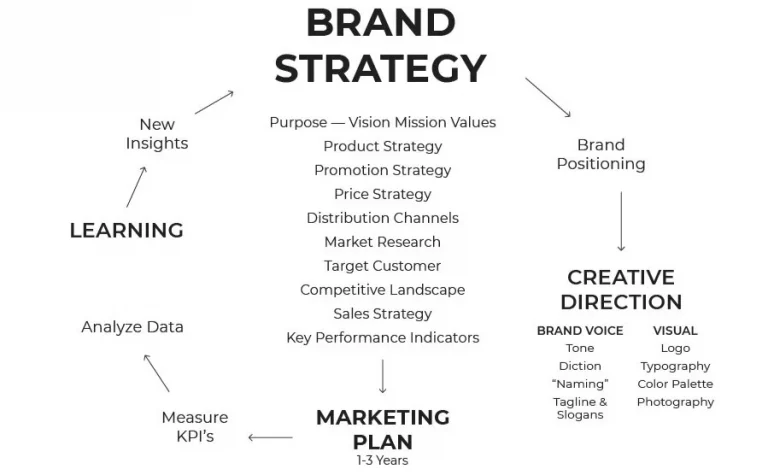How to Make a Brand Strategy?

What is a Brand Strategy?
A brand strategy is a long-term plan developed by a company or organization to establish and promote its brand identity in a consistent and impactful manner. It involves making strategic decisions about how the brand will be positioned, communicated, and perceived in the market.
A brand strategy outlines the unique attributes, values, and personality that the brand wants to convey to its target audience. It takes into consideration the company’s mission, vision, and overall business objectives. It involves defining the brand’s target market, understanding their needs and preferences, and identifying how the brand can meet those needs better than its competitors.
Key components of a brand strategy include:
-
Brand positioning: Determining how the brand wants to be perceived relative to its competitors. This involves identifying the brand’s unique selling proposition and creating a distinct position in the market.
-
Brand messaging: Developing a clear and compelling message that communicates the brand’s value, benefits, and differentiation. This message should resonate with the target audience and consistently be communicated across various marketing channels.
-
Brand identity: Creating a visual and verbal representation of the brand through elements such as logo, colors, typography, tagline, and tone of voice. These elements should align with the brand’s values and resonate with the target audience.
-
Brand experience: Ensuring that every interaction a customer has with the brand, whether through products, services, or customer support, reflects the brand’s values and reinforces its desired image.
-
Brand guidelines: Establishing guidelines and standards for the consistent use of brand elements across all communication channels and touchpoints. This helps maintain brand integrity and ensures a unified brand experience.
-
Brand monitoring and adaptation: Regularly monitoring and evaluating how the brand strategy is performing and making necessary adjustments to stay relevant and competitive in the market. This may involve conducting market research, tracking customer feedback, and analyzing market trends.
A well-defined brand strategy helps build brand recognition, loyalty, and equity. It guides marketing and communication efforts, supports business growth, and creates a strong emotional connection between the brand and its target audience.
Branding Strategies
The basics of a brand strategy can vary depending on the specific goals and needs of a company, but here are some common approaches:
Differentiation
This strategy focuses on highlighting unique attributes and qualities that set the brand apart from competitors. It involves identifying and communicating a distinct value proposition, such as superior quality, innovative features, exceptional customer service, or a specific niche market focus.
Targeting
This strategy involves defining a specific target audience or market segment that the brand aims to serve. By understanding the needs, preferences, and behaviors of the target audience, the brand can tailor its messaging, products, and experiences to effectively reach and resonate with them.
Positioning
Positioning strategy involves determining how the brand wants to be perceived in the minds of customers relative to its competitors. It may involve emphasizing a specific benefit, attribute, or image that differentiates the brand in the market. Effective positioning helps create a clear and memorable brand identity.
Brand extension
This strategy involves leveraging the existing brand equity and reputation to introduce new products, services, or ventures in related or even unrelated markets. Brand extensions can capitalize on the familiarity and trust associated with the brand, but careful consideration should be given to ensure that the extension aligns with the brand’s core values and does not dilute its equity.
Brand consistency
Consistency is crucial in brand strategy. This strategy focuses on maintaining a unified and coherent brand experience across all touchpoints and communication channels. Consistent use of brand elements, messaging, and values helps build trust, recognition, and loyalty among customers.
Emotional branding:
Emotional branding strategy aims to create a strong emotional connection between the brand and its target audience. It involves crafting stories, narratives, and experiences that evoke specific emotions and resonate with customers on a deeper level. Emotional branding can help foster loyalty and long-term relationships with customers.
Brand advocacy
This strategy focuses on turning customers into brand advocates by providing exceptional experiences, fostering positive relationships, and encouraging word-of-mouth referrals. Brand advocates become loyal and enthusiastic ambassadors who actively promote the brand to others, thus expanding its reach and credibility.
Five ways companies may quickly build brand awareness:
Social Media Marketing:
- Reach a large audience rapidly through social media.
- Make brand-appropriate, shareable content.
- Engage industry groups, engage in meaningful discussions, and work with influencers to grow your reach.
Paid social media advertising may target demographics and boost brand exposure.
Influencer Partnerships: Find high-profile industry influencers. Promote your company and brand with them. Sponsored content, guest appearances on their platforms, and co-creation may achieve this. Influencers may help you reach their audience and gain consumer trust.
Content Marketing:
- Create quality and relevant material that matches your target audience’s interests using a content marketing plan.
- Create a blog, video, webinar, or podcast.
- Promote your material via social media, email, and industry forums.
Quality content builds your startup’s credibility and brand recognition.
Attend important industry events, conferences, and trade exhibitions. Set up a booth, present, or join a panel to network with possible clients. These events are significant for branding, networking, and industry reputation.
Collaborate with Other Brands: Find startups or companies that complement your goods or services without competing. Explore cross-promotion, cooperative marketing, and packaged offers. Collaborating with like-minded firms lets you tap into their client base, reach new audiences, and boost brand exposure for both sides.
Brand awareness requires time and perseverance. Maximize these initiatives with a consistent brand message, powerful visual identity, and outstanding customer experiences. Adjust your strategy depending on comments and insights.


